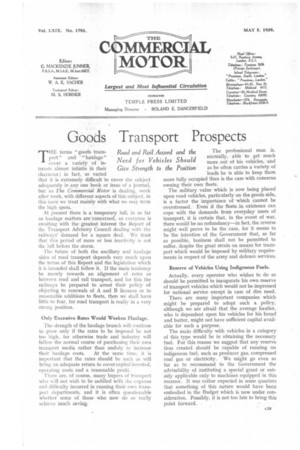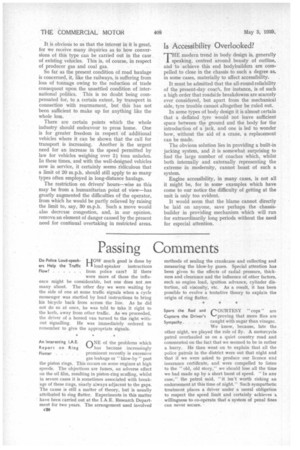Goods Transport Prospects T HE terms "goods transport" and " haulage
Page 69

Page 70

If you've noticed an error in this article please click here to report it so we can fix it.
" cover a 'variety of interests almost infinite in their character ; in fact, so varied that it is extremely difficult to cover the subject adequately in any one book_ or issue of a journal, but as The Commercial Motor is dealing, week after week, with different aspects of this subject, in 'this issue we treat mainly with what we may term the high spots.
At present there is a temporary lull, in so far as haulage matters are concerned, as everyone is awaiting with the greatest interest the Report of the Transport Advisory Council dealing with the railways' demand Ior a square deal. We trust that this period of more or less inactivity is not the lull before the storm.
The future of both the ancillary and haulage sides of road transport depends very much upon the terms of this Report and the legislation which it is intended shall follow it. If the main tendency be merely towards an alignment of rates as between road and rail transport, and for this the railways be prepared to arrest their policy of objecting to renewals of A and B licences or to reasonable additions to fleets, then we shall have little to fear, for road transport is really in a very strong position. Road and Rail Accord Need for Vehicles Give Strength to the Only Excessive Rates Would Weaken Haulage.
The strength of the haulage branch will continue to grow only if the rates to be imposed be not too high, for otherwise trade and industry will follow the normal course of purchasing their own transport media rather than unduly to increase their haulage costs. At the same time, it is important that the rates should be such as will bring an adequate return to cover capital invested, operating costs and a reasonable profit.
There are, of course, many buyers of transport who will not wish to be saddled with the expense and difficulty incurred in running their own transport departments, and it is often questionable whether some of those who now do so really achieve much saving. and the The professional man is, Should normally, able to get much more out of his vehicles, and Position as he often carries a variety of loads he is able to keep them more fully occupied than is the case with concerns owning their own fleets. The military value which is now being placed upon road vehicles, particularly on the goods side, is a factor the importance of which cannot be overstressed. Even if the fleets in existence can cope with the demands from everyday users of transport, it is certain that, in the event of war, there would be no redundancy—in fact, the reverse might well prove to be the case, for it seems to be the intention of the Government that, so far as possible, business shall not be permitted to suffer, despite the great strain on means 'for transport which would be imposed by military requirements in respect of the army and defence services.
Reserve of Vehicles Using Indigenous Fuels.
Actually, every operator who wishes to do so should be permitted to inaugurate his own reserve of transport vehicles which would not be impressed for national service except in case of dire need.
There are many important companies which might be prepared to adopt such a policy, although we are afraid that the average haulier, who is dependent upon his vehicles for his bread and butter, might not have sufficient capital available for such a purpose.
The main difficulty with vehicles in a category of this type would be in obtaining the necessary fuel. For this reason we suggest that any reserve thus created should be capable of running on indigenous fuel, such as producer gas, compressed coal gas or electricity. We might go even so far as to recommend to the Government the advisability of instituting a special grant or subsidy applicable only to machines equipped in this manner. It was rather expected in some quarters that something of this nature would have been embodied in the Budget which is now under consideration. Possibly, it is not too late to bring this point forward. It is obvious to us that the interest in it is great, for we receive many inquiries as to how conversions of this type can be carried out in the case of existing vehicles. This is, of course, in respect of producer gas and coal gas.
So far as the present condition of road haulage is concerned, it, like the railways, is suffering from loss of tonnage owing to the reduction of trade consequent upon the unsettled condition of international politics. This is no doubt being compensated for, to a certain extent, by transport in connection with rearmament, but this has not been sufficient to make up for anything like the whole loss.
There are certain points which the whole industry should endeavour to press home. One is for greater freedom in respect of additional vehicles where it can be shown that the call for transport is increasing. Another is the urgent need for an increase in the speed permitted by law for vehicles weighing over 2i tons unladen. In these times, and with the well-designed vehicles now in service, it certainly seems ridiculous that a limit ot 20 m.p.h. should still apply to so many types often employed in long-distance haulage.
The restriction on drivers' hours—wise as this may be from a humanitarian point of view—has greatly augmented the difficulties of the operator, from which he would be partly relieved by raising the limit to, say, 30 m.p.h. Such a move would also decrease congestion, and, in our opinion, remove an element of danger caused by the present need for continual overtaking in restricted areas.
Is Accessibility Overlooked?
THE modern trend in body design is, generally speaking, centred around beauty of outline, and to achieve this end bodybuilders are compelled to close in the chassis to such a degree as+ in some cases, materially to affect accessibility. .
It must be admitted that the all-round reliability of the present-day coacla, for instance, is of such a high order that roadside breakdowns are scarcely ever considered, but apart from the mechanical side, tyre trouble cannot altogether be ruled out.
In some types of body design it is almost certain that a deflated tyre would not leave sufficient space between the ground and the body for the introduction of a jack, and one is led to wonder how, without the aid of a crane, a replacement can be made.
The obvious solution lies in providing a built-in jacking system, and it is somewhat surprising to find the large number of coaches which, whilst both internally and externally representing the extreme in modernity, cannot boast of such a system.
Engine accessibility, in many cases, is not all it might be, for in some examples which have come to our notice the difficulty of getting at the unit is only too evident.
It would seem that the blame cannot directly be laid on anyone, save perhaps the chassisbuilder in providing mechanism which will run for extraordinarily long periods without the need for especial attention.
































































































































































